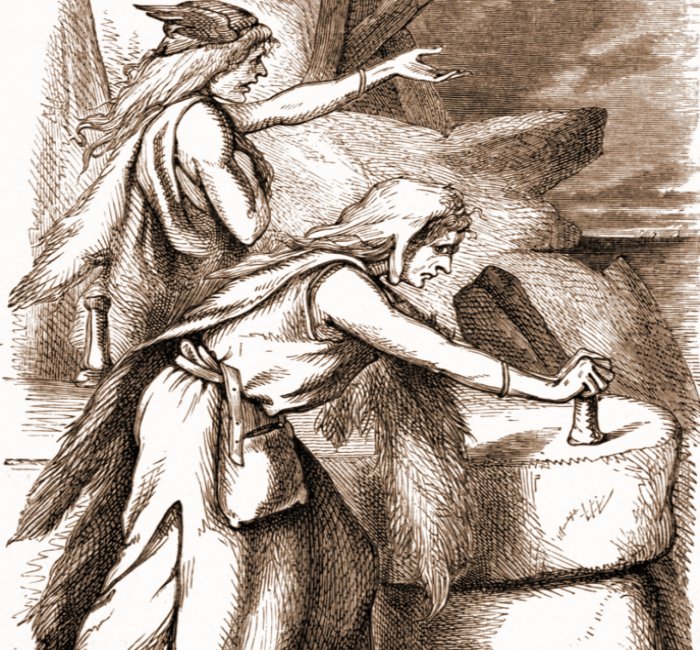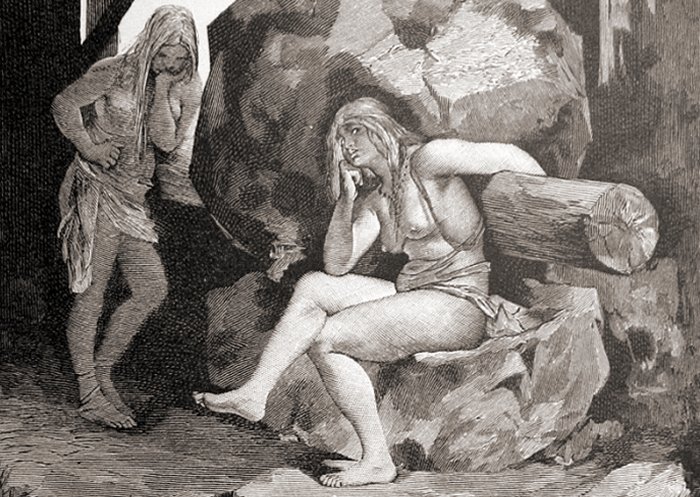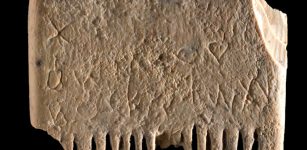Fenja And Menja: Two Giant Sisters, Magical Grotte Mill And Why The Sea Is Salt
A. Sutherland - AncientPages.com - In Norse legends, Fenja and her sister Menja were two giant maidens who mined gold in the Grotte (or the 'World Mill'). It was a legendary, magical mill with two massive millstones that no man had enough strength to grind.
 Menia (Menja) and Fenia (Fenja) by W. J. Wiegand, (fl. 1869–1882). source
Menia (Menja) and Fenia (Fenja) by W. J. Wiegand, (fl. 1869–1882). source
The magical mill could grind everything, both good things, including gold, peace, happiness, and terrible things like war, tragedy, and ruin.
Moreover, the mill's magic was that it could grind out what the mill drivers were singing about, but as legend has it, no one had been strong enough to operate the mill.
Initially, Fenja and Menja served for King Fjolner, who lived from the 1st century BC to the early 1st century AD and was the son of Frey (Freyr) and the giantess Gerdr (Gertha), the Ynglinga saga tells. Their story is also mentioned in 'Song of Grótti' (Grottasöngr), an Old Norse poem found in the Poetic Edda and preserved in one of the manuscripts Prose Edda by Snorri Sturluson.
Ruthless King Frode Bought Fenja And Menja
One day, Fjolner (Fjölner) was visited by a Danish King Frode (Frodi) from Zealand, the island, which - as told in the Gylfaginning - was created by Gefjon (Gefion). We remember that Gefjon was the Aesir goddess of fertility, plow, and agriculture.
She cleverly tricked Gylfi, the king of Sweden, by removing a piece of land and transporting it to Denmark, which became Zealand.
King Frode bought the slave giantesses, Fenja and Menja, to care for his powerful Grotti mill, which had magical properties. It is said that he got it from the mighty god Odin himself.
When he got home, he was eager to put the women to work. Perhaps King Frode's rule was prosperous and delivered a peaceful time for his people, but it was not the same for the giants. Frode was a cruel, heartless, and greedy man.
He tied Fenja and Menja to the mill and ordered them to grind gold, peace, happiness, and prosperity for him. In his ruthless greed, he did not allow the girls to sleep for more than a moment. The sisters could not rest for more than the time it took to perform a song.
Was it their fate to be enslaved forever?
Even though mortals had enslaved Fenja and Menja, the girls, fortunately, knew that sooner or later, they would be able to take revenge.
Fenja's And Menja's Revenge
As the sisters worked with the mill, they soon discovered its supernatural powers and learned to control them. Thus, they created a power song we know today as the "Song of Grotte." Before the music ended, they ground an enemy army into existence via the magic mill. This army was led by a king, Mysing, "from over the sea," who was powerful enough to oust Frode, so he did.
 The engraving shows the giantesses Fenja and Menja beside the mill Grótti. One giantess is sitting near the center of the frame while the other is standing by the side. Carl Larsson (1853-1919) and Gunnar Forssell (1859-1903). Published in 1893. Original drawing created in 1886.
The engraving shows the giantesses Fenja and Menja beside the mill Grótti. One giantess is sitting near the center of the frame while the other is standing by the side. Carl Larsson (1853-1919) and Gunnar Forssell (1859-1903). Published in 1893. Original drawing created in 1886.
King Mysing quickly killed Frode and took the slave women and the Grotte mill on his ship with him.
Unfortunately, also this time, the girls did not have much luck because Mysing was not better than Frode. Frode wanted unlimited quantities of gold, reminding us of King Midas, who – as told in an ancient Greek myth – was wealthy and greedy and loved gold more than anything else.
King Mysing, on the other hand, wanted to possess unlimited quantities of salt; he forced the sisters to grind it even harder without getting any rest.
Around midnight, they asked if there was not enough salt, but it was not. Mysing wanted more and ordered the women to continue grinding. In revenge for their endless suffering, the two giant women started to sing the "Song of Grotti," which brought misfortune to Frode. This time, however, the sisters did not intend to give up their fate but fought to the end.
They worked only a short time longer before the disaster happened.
In the sea, a gigantic vortex, known as the Maelstrom (Mill-Stream), formed by the sea spiraling through the hole in the millstone of Grotte. Mysing's ship broke down, was pulled down through this powerful opening, and sank. All Mysing's ships went down; the Grotte Mill also fell with them.
The sea began turning salt. Since then, the sea has been salty, says the myth.
Where Are Fenja And Menja Now?
According to some old stories, the two unhappy girls still work at the mill. One version of the myth says that the two sisters, no longer oppressed and humiliated by any man, happily returned to Jotunheim with Grotte, which they used to grind out gold dust and export to many places worldwide. Their house - covered in gold dust - was often visited by people who wanted to steal the magical mill or the sisters' wealth. None of those visitors have yet survived to tell the story.
Another legend says that Stroma, an island off the northern coast of the mainland of Scotland, is known to have a dangerous whirlpool with a Norse name: Swelki ("sea mill"). Legend has it that two giant women, Grotti-Fenni and Grotti-Meni, live under the seafloor and cause dangerous whirlpools - an unavoidable threat to passing sailors.
Written by – A. Sutherland - AncientPages.com Senior Staff Writer
Updated on August 5, 2024
Copyright © AncientPages.com All rights reserved. This material may not be published, broadcast, rewritten or redistributed in whole or part without the express written permission of AncientPages.com
Expand for referencesReferences:
Stephen Liley, Olaf's Saga
Sturluson S. The Younger Edda
Sora S. The Triumph of the Sea Gods
More From Ancient Pages
-
 Evidence Of A Hybrid Population Of Neanderthals And Modern Humans Discovered At La Cotte De St Brelade
Archaeology | Feb 9, 2021
Evidence Of A Hybrid Population Of Neanderthals And Modern Humans Discovered At La Cotte De St Brelade
Archaeology | Feb 9, 2021 -
 Unas (Unis): First Pharaoh Who Decorated His Burial Chamber With Pyramid Texts
Featured Stories | Jun 3, 2021
Unas (Unis): First Pharaoh Who Decorated His Burial Chamber With Pyramid Texts
Featured Stories | Jun 3, 2021 -
 8,000 Year-Old Human Skeleton Discovered By Cave Divers Near Tulum, Mexico
Archaeology | Sep 15, 2022
8,000 Year-Old Human Skeleton Discovered By Cave Divers Near Tulum, Mexico
Archaeology | Sep 15, 2022 -
 Nabopolassar: Father Of Nebuchadnezzar II And King Of Babylon Rose To Power Thanks To His Dedication To Gods Nabu And Marduk
Featured Stories | Jan 11, 2019
Nabopolassar: Father Of Nebuchadnezzar II And King Of Babylon Rose To Power Thanks To His Dedication To Gods Nabu And Marduk
Featured Stories | Jan 11, 2019 -
 Fascinating Ancient History Of Roman Shields
Featured Stories | Oct 1, 2018
Fascinating Ancient History Of Roman Shields
Featured Stories | Oct 1, 2018 -
 New Video Footage Reveals Intriguing Viking-Style Shipwreck At The Bottom Of Norway’s Largest Lake Mjøsa
Archaeology | May 5, 2023
New Video Footage Reveals Intriguing Viking-Style Shipwreck At The Bottom Of Norway’s Largest Lake Mjøsa
Archaeology | May 5, 2023 -
 Ancient Hindu Sheetal Temple Vandalized – Lord Shiva And Elephant God Ganesha Statues Destroyed
News | Nov 3, 2020
Ancient Hindu Sheetal Temple Vandalized – Lord Shiva And Elephant God Ganesha Statues Destroyed
News | Nov 3, 2020 -
 Ancient Desert Mystery – Did Thousands Vanish Without A Trace Because Of An Ominous Prophecy And Revenge?
Ancient Mysteries | Nov 28, 2022
Ancient Desert Mystery – Did Thousands Vanish Without A Trace Because Of An Ominous Prophecy And Revenge?
Ancient Mysteries | Nov 28, 2022 -
 Has A New Study Of 5,000-Year-Old DNA Solved The Mystery Of The Tarim Basin Mummies?
Civilizations | Mar 31, 2022
Has A New Study Of 5,000-Year-Old DNA Solved The Mystery Of The Tarim Basin Mummies?
Civilizations | Mar 31, 2022 -
 Mysterious Inca Citadel With Platforms, Passages And Walls Discovered In Peru’s Rainforest
Archaeology | Oct 15, 2017
Mysterious Inca Citadel With Platforms, Passages And Walls Discovered In Peru’s Rainforest
Archaeology | Oct 15, 2017 -
 Tomb Of Pharaoh Ramesses II Treasurer Ptah-M-Wia Discovered In Saqqara
Archaeology | Nov 4, 2021
Tomb Of Pharaoh Ramesses II Treasurer Ptah-M-Wia Discovered In Saqqara
Archaeology | Nov 4, 2021 -
 Breakthrough – First Sentence Ever Written In Canaanite Language Discovered – What Does It Say?
Archaeology | Nov 9, 2022
Breakthrough – First Sentence Ever Written In Canaanite Language Discovered – What Does It Say?
Archaeology | Nov 9, 2022 -
 Advanced Ancient Technology – Talos A Greek Robot Created By The God Of The Forge
Featured Stories | Jun 28, 2014
Advanced Ancient Technology – Talos A Greek Robot Created By The God Of The Forge
Featured Stories | Jun 28, 2014 -
 Invention Of Ancient Military Technologies Throughout World History Investigated
Archaeology | Oct 23, 2021
Invention Of Ancient Military Technologies Throughout World History Investigated
Archaeology | Oct 23, 2021 -
 Hiawatha And The Legendary Great Peacemaker – Native American Heroes Who Founded The League Of The Iroquois
Featured Stories | Feb 25, 2019
Hiawatha And The Legendary Great Peacemaker – Native American Heroes Who Founded The League Of The Iroquois
Featured Stories | Feb 25, 2019 -
 Native American Legend Of Apotamkin Teaches Children Obedience
Featured Stories | May 14, 2019
Native American Legend Of Apotamkin Teaches Children Obedience
Featured Stories | May 14, 2019 -
 On This Day In History: Supernova Observed In The Constellation Cassiopeia Was Recorded – On August 4, 1181
News | Aug 4, 2016
On This Day In History: Supernova Observed In The Constellation Cassiopeia Was Recorded – On August 4, 1181
News | Aug 4, 2016 -
 Machu Picchu: Ancient Incan Sanctuary Intentionally Built On Faults
Archaeology | Sep 27, 2019
Machu Picchu: Ancient Incan Sanctuary Intentionally Built On Faults
Archaeology | Sep 27, 2019 -
 Goddesses Of Fate And Destiny In Greek, Roman And Slavic Mythologies
Featured Stories | Sep 28, 2017
Goddesses Of Fate And Destiny In Greek, Roman And Slavic Mythologies
Featured Stories | Sep 28, 2017 -
 Wars Of The Roses: Thirty Two Years Of Struggle To Claim English Throne
Featured Stories | Aug 5, 2017
Wars Of The Roses: Thirty Two Years Of Struggle To Claim English Throne
Featured Stories | Aug 5, 2017
